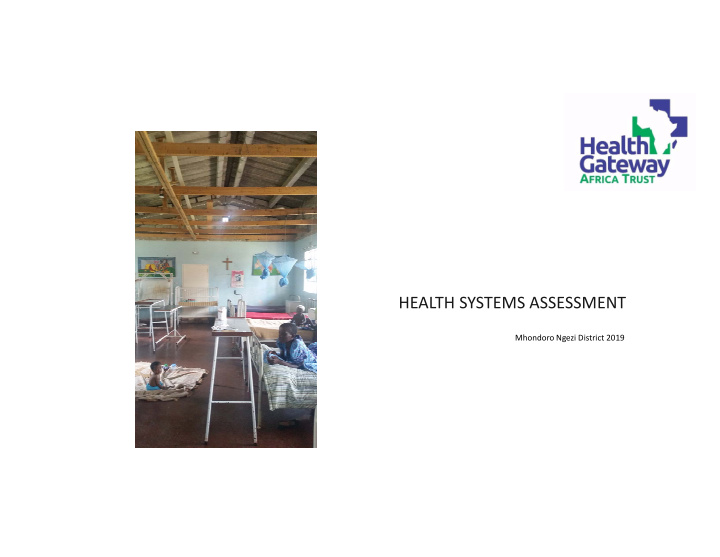



HEALTH SYSTEMS ASSESSMENT Mhondoro Ngezi District 2019
Purpose, Objectives and Program Trajectory
Purpose, Objectives and Program Trajectory Disadvantaged communities Women and children ‘HealthGateway Africa Trust’ Access to Health Care Community empowerment
Outcomes?
Outcomes Increase universal Need‐based access coverage to care Increase Health equity community participation
Mhondoro Ngezi Project
Mhondoro Ngezi Project Phase 1 Phase 2 Increasing service delivery Increasing community uptake capacity health care services o Providing hospital Equipment o Evidence‐based community awareness campaigns o Sundries o Service outreach support o Facility refurbishment Increasing facility range of Preventing disease occurrence services by boosting resilience o Sponsoring required personnel, & o Directly through increasing access instituting phased service payment to nutritional supplements scheme for gradual self o In‐directly through strengthening sustainability livelihood & quality of life
Range Of Items Measured
Range Of Items Measured In line with phase 1 objectives Disease Institutional capacity Services Review of external support programmin g health prevalence, severity, seeking expertise medication equipment affordability accessibility behavior
FINDINGS: Disease Prevalence and Severity
FINDINGS: Disease Prevalence and Severity Excessive Causes Organ Sudden Unhealthy Blindness alcohol stroke failure death diet intake There is no medicine Life‐style condition Mental Hypertension (BP) 45 years of age and above Diabetes Asthma Illness
FINDINGS: Disease Prevalence and Severity Mhondoro Ngezi District 2018 Disease Prevanence By Gender 202 CONDIT. REQUIRING REHAB SERVICES 190 2 ALL OTHER CANCERS 2 0 CA PROSTATE 4 1 CA CERVIX 0 0 CA BREAST 0 5 CHRON. RENAL FAILURE 9 65 CHRON. CON. HEART FAILURE 33 87 RHEUM. HEART DISEASE 26 3640 HYPERTENSION 2593 347 MENTAL ILLNESS 342 136 EPILEPSY 124 3 LEPROSY 2 381 ASTHMA 302 391 DIABETES 352 0 500 1000 1500 2000 2500 3000 3500 4000 Female Prevalence Male Prevalence
FINDINGS: Disease Prevalence and Severity St Michaels Ward 2018 Disease Prevalence by Gender 28 CONDIT. REQUIRING REHAB SERVICES 30 2 ALL OTHER CANCERS 0 0 CA PROSTATE 0 0 CA CERVIX 0 0 CA BREAST 0 4 CHRON. RENAL FAILURE 1 50 CHRON. CON. HEART FAILURE 26 4 RHEUM. HEART DISEASE 0 647 HYPERTENSION 197 45 MENTAL ILLNESS 86 61 EPILEPSY 37 0 LEPROSY 0 25 ASTHMA 50 140 DIABETES 41 0 100 200 300 400 500 600 700 Female Prevalence Male Prevalence TABLE 2 : In St Michaels ward 1, women are 3 times more susceptible than men to developing Hypertension and Diabetes.
Health Seeking Behaviour
Health Seeking Behaviour HIV Cross cutting among ‐ wide variety Early child Teenagers with HIV of conditions marriages Non‐ disclosure Men = low health seeking behavior causes wrong Tuberculosis (TB) diagnosis STIGMA fuels Non‐ Cancers = ignorance Hospital disclosure staff not trained or Traditional experienced myths & misconcepti Let alone ons the High community illiteracy rate
Institutional Expertise, Medication, Equipment Capacity
Expertise No retention of St Michaels Ngezi Hospital professional staff Theatre professionals Doctor Mental health nurses Professional counsellors Eye surgeon A single ambulance driver Dentist No dedicated trained security
Medication
Medication St Michaels Hospital ‐ Ngezi Hospital ‐ Medicine and Medication and consumables = consumables in low supply low supply Includes Hypertension 2 nd line medication Drugs for Hypertension Oxygen tanks Mental illness Resuscitation medication Epilepsy Facilities, and equipment Antibiotics in Analgesics i. No mortuary ii.No ambulance iii.Need for WIFI to improve communication Wound dressing towels Results Based Financing (RBF) resources inadequate.
Equipment
Equipment Technical Equipment Non‐technical Equipment Clients: To improve client’s quality Increasing Capacity via Equipment of life increasing chances of improved well‐being. Reducing Workload via Prevention Providers: To improve provider activities : To reduce and eventually working conditions, effectiveness eliminate targeted ailments (group‐ and staff retention. counselling sessions) St Michaels and Ngezi hospitals under capacitated General infrastructure not conducive for hospital operations
Equipment St Michaels Hospital Ngezi Hospital Gadgets Gadgets a.BP machines a.BP/ Hypertension assessment machines b.Diabetes machines (re‐usable) Equipment a.Scales to weigh children & adults b.Photocopier not working Equipment c.Beds old and malformed – blankets and a.No IT equipment and staff also not trained for ICT mattresses tattered and torn (at least 10 computers required) d.Cleaning equipment (mop with bucket b.Physiotherapy training machines and rollers) c.Medicine trolleys (at least 6 needed) e.Curtains d.Surgical trolleys (at least 10 needed) f.Washing machine not working e.Kitchen ware needed g.Generator not working f.Chairs for staff and clients h.Fridges not working g.Sundries – of the 60 hospital beds, most of them i.Hospital has no ambulance are obsolete; 104 lockers old and rusty – used j.Sluicing Expecting mothers have no stove since 1984 Facilities and Infrastructure Facilities and Infrastructure •Sluice room needs refabricating a.Water supply pipe system needs to be changed from galvanized to PVC to stop water calcifying. b.Back‐up borehole urgently required c.Sluice room needs refabricating
Services Affordability and Facility Accessibility
Services Affordability and Facility Accessibility Results‐Based Financing (RBFs) Effect core outputs Resource allocation Deliveries Allocation structure Performance management Consultations 75% of RBF = 25% = staff Allocation differ hospital demands incentives with institution Performance‐ Immunization based reward
AFFORDABILITY: St Michaels Mission Hospital Medicines Hospital = charged can re‐ at cost stock price
AFFORDABILITY: St Michaels Mission Hospital Introduction of RBFs Hospital’s capacity reduced to by half
AFFORDABILITY: St Michaels Mission Hospital Consultation Admission fees fees 25% cannot 50% cannot afford to pay afford to pay Cost RTGS$ 5 Cost RTGS$ 5 per day
AFFORDABILITY: Ngezi Hospital Consultation = RTGS$ 2. 50% cannot afford. Service free for under 5s and over 65s. Maternity patients pay a fee & bring material needed.
Review of External Support Programing
Review of External Support Programing No stake‐holder Low ingenuity Programmer conflict of consultation. No sense programming models. interests. Overstating of ownership. Poor or no transitional demand to donors Incompatibility or exit plans Hospitals not Incentivizing health Abuse of Donated distribution centres. facility staff for specific items. Controls & Sponsors should have outputs it skews facility monitoring critical. own distribution plans. outputs Commodity allocation should be based on need & performance. Audit critical. Pilot critical.
Lets chat…
Recommend
More recommend